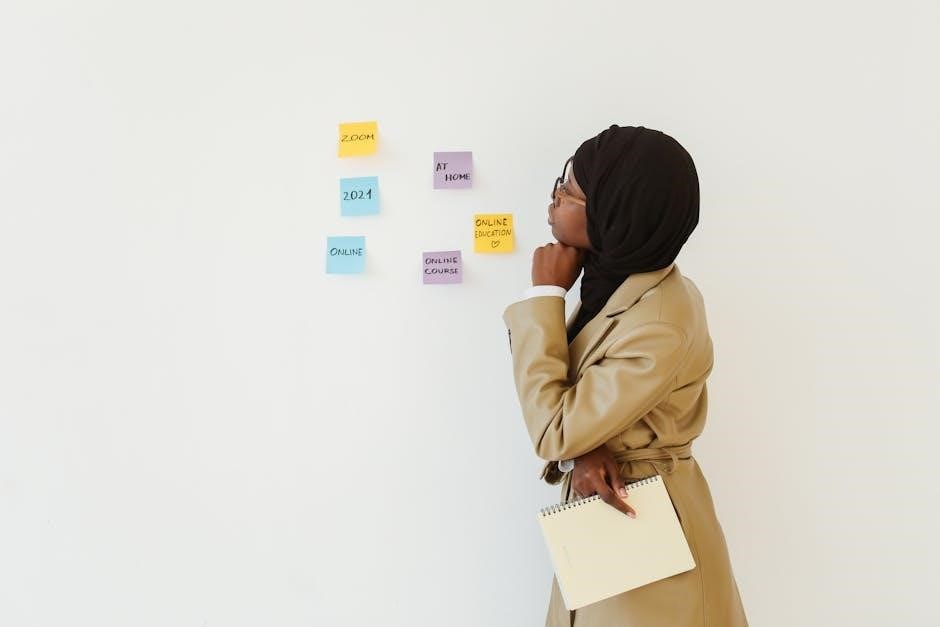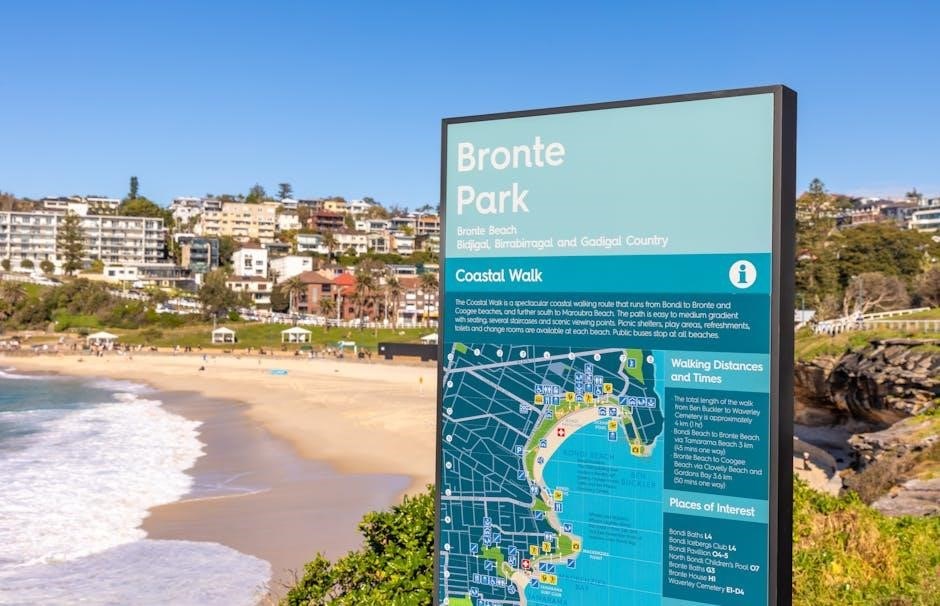Thinking Maps are a set of eight visual tools based on fundamental cognitive processes, designed to enhance learning and critical thinking across all subjects and grade levels.

What Are Thinking Maps?
Thinking Maps are a set of eight visual tools designed to represent fundamental cognitive processes. They provide a common visual language for learning and teaching, helping individuals organize ideas, analyze information, and solve problems. Each map corresponds to a specific thinking skill, such as defining concepts, describing qualities, comparing, and sequencing. By visually representing thoughts, Thinking Maps enable deeper understanding and enhance critical thinking. They are widely used in education to support diverse learners and promote collaborative learning environments. These maps are adaptable across subjects and grade levels, making them a versatile resource for both students and educators. Their visual structure simplifies complex thinking processes, fostering clarity and creativity in learning.

The Purpose of Thinking Maps
The primary purpose of Thinking Maps is to provide a consistent visual language that enhances learning and critical thinking. They are designed to help students and professionals organize ideas, analyze information, and solve problems effectively. By aligning with fundamental cognitive processes, Thinking Maps enable users to visually represent their thoughts, making complex concepts more manageable. Their ultimate goal is to foster deeper understanding, creativity, and collaboration. They are particularly useful in educational settings to support diverse learners and improve academic outcomes. Beyond education, Thinking Maps also serve as valuable tools in professional environments, aiding in decision-making and problem-solving. Overall, their purpose is to empower individuals to think more effectively and communicate their ideas with clarity.
The Cognitive Processes Behind Thinking Maps
Thinking Maps are rooted in eight fundamental cognitive processes: defining, describing, comparing, sequencing, categorizing, deconstructing, identifying relationships, and analyzing causes and effects. These processes are universal and essential for learning, enabling individuals to organize thoughts and ideas visually. Each map corresponds to a specific cognitive skill, providing a structured way to engage with information. For instance, defining concepts helps clarify ideas, while comparing and contrasting fosters analytical thinking. These processes are transferable across subjects, making Thinking Maps a versatile tool for education and professional settings. By aligning with how the brain processes information, Thinking Maps enhance higher-order thinking and problem-solving abilities, promoting deeper understanding and effective communication.

The Eight Thinking Maps
The Eight Thinking Maps are visual tools designed to organize ideas and thoughts, each aligned with a specific cognitive process, enabling effective learning and problem-solving across all subjects.
Circle Map: Defining Concepts
The Circle Map is a visual tool used to define concepts and ideas, helping users understand and explore the meaning of a central topic. It consists of a central circle containing the main idea, surrounded by other circles or bubbles that provide details, descriptions, or examples related to the concept. This map is particularly useful for brainstorming, examining perspectives, and generating ideas. By visually organizing information, it enables learners to clarify their understanding and identify relationships between the core concept and its attributes. For instance, a Circle Map could be used to define a term like “democracy” or “photosynthesis,” with the central circle containing the term and the surrounding circles offering explanations, examples, or key characteristics. This tool promotes critical thinking and effective communication by providing a structured approach to conceptual understanding.
Bubble Map: Describing Qualities

The Bubble Map is a visual tool designed to describe the qualities, characteristics, or attributes of a concept, idea, or object. It consists of a central bubble containing the main topic, with additional bubbles branching out to detail its various features. This map is ideal for exploring adjectives, traits, or components that define something. For example, a Bubble Map could describe a historical figure by outlining their personality, achievements, and challenges. It helps learners organize their thoughts and identify key descriptors, making it easier to analyze and communicate complex ideas. By focusing on the attributes of a subject, the Bubble Map enhances descriptive writing, critical thinking, and the ability to articulate details effectively.
Double Bubble Map: Comparing and Contrasting
The Double Bubble Map is a visual tool used to compare and contrast two subjects, ideas, or concepts. It consists of two central bubbles, each representing one subject, with connecting bubbles that highlight their similarities and differences. This map helps learners organize their thoughts by visually separating unique attributes from shared qualities. For example, it can compare two historical figures, literary characters, or scientific theories. The Double Bubble Map fosters critical thinking by encouraging users to analyze relationships and distinctions. It is particularly useful for developing comparison skills, enhancing writing, and preparing for discussions or debates. By structuring information clearly, it simplifies complex comparisons and promotes a deeper understanding of the subjects being analyzed.

Flow Map: Sequencing
The Flow Map is a visual tool designed to sequence events, processes, or ideas in a chronological or logical order. It helps learners organize information into a clear progression, making it easier to understand cause-and-effect relationships or the steps in a procedure. The map typically consists of a series of connected boxes or nodes, with arrows indicating the flow from one step to the next. This tool is particularly useful for planning projects, recounting events, or explaining timelines. By visually structuring sequences, the Flow Map enhances comprehension and memory retention. It is widely used in education and professional settings to clarify workflows, historical timelines, or narrative storylines, making complex processes more manageable and accessible for learners of all ages.
Tree Map: Categorizing
The Tree Map is a visual tool used to categorize and organize ideas or information hierarchically. It begins with a central idea, which branches out into main categories and subcategories, allowing users to see relationships between groups. This map is ideal for tasks like classifying concepts, brainstorming ideas, or structuring content for essays or projects. By visually separating and grouping information, the Tree Map helps learners identify patterns, prioritize ideas, and understand how different elements fit together. It is widely applied in various subjects, such as science for taxonomy or language arts for essay planning, making it an essential tool for organizing and analyzing information effectively.
Brace Map: Deconstructing
The Brace Map is a visual tool designed to break down complex ideas or objects into their constituent parts, allowing users to understand how each part contributes to the whole. It is structured with a central idea or object, supported by “braces” that detail its components or attributes. This map is particularly useful for analyzing structures, such as literary texts, scientific concepts, or historical events, by identifying and examining their key elements. By visually deconstructing information, the Brace Map helps learners develop a deeper understanding of how parts interact within a system or framework. It is an essential tool for promoting analytical and problem-solving skills, making it applicable across various academic disciplines and real-world scenarios.
Bridge Map: Identifying Relationships
The Bridge Map is a visual tool used to identify and explore relationships between two or more ideas, concepts, or topics. It helps users create connections and analogies by structuring information in a way that highlights similarities, differences, or cause-and-effect relationships. This map is particularly useful for understanding complex systems, analyzing literary themes, or comparing historical events. By visually linking ideas, the Bridge Map fosters critical thinking and problem-solving skills, enabling learners to see how different components interact and influence one another. It is widely applied in education and professional settings to enhance collaboration and deepen understanding of interconnected concepts.
Multi-Flow Map: Analyzing Causes and Effects
The Multi-Flow Map is designed to analyze complex causal relationships, allowing users to explore multiple causes and effects of a single event or issue. This map is ideal for understanding systems, historical events, or scientific phenomena where various factors interact. It helps learners organize information hierarchically, showing how different elements contribute to outcomes. The Multi-Flow Map enhances critical thinking by encouraging users to consider multiple perspectives and evaluate the impact of each factor. It is widely used in education and professional settings to simplify intricate relationships, making it easier to identify patterns, understand consequences, and develop well-rounded solutions. This tool is essential for fostering deeper analytical and problem-solving skills.
Applications of Thinking Maps
Thinking Maps are widely applied in education, professional settings, and personal growth, aiding in problem-solving, decision-making, and fostering collaboration across diverse contexts and industries.
Thinking Maps in Education
Thinking Maps are widely used in educational settings to enhance learning and critical thinking. They provide a visual language for organizing ideas, defining concepts, and comparing information. Teachers use these tools to help students structure their thoughts, improve problem-solving skills, and collaborate effectively. For example, Circle Maps aid in defining concepts, while Double Bubble Maps facilitate comparisons. By aligning with cognitive processes, Thinking Maps make complex ideas accessible and promote deeper understanding. They are particularly effective in diverse subjects, from language arts to science, and cater to students of all ages and abilities. This approach not only improves academic outcomes but also fosters resilience and independence in learners, making it a valuable resource for educators seeking to engage students and enhance their thinking capabilities.

Thinking Maps in Professional Settings
Thinking Maps are increasingly valued in professional environments to enhance communication, collaboration, and problem-solving. Professionals use these visual tools to brainstorm ideas, plan strategies, and analyze complex issues. For instance, Flow Maps are ideal for process analysis, while Multi-Flow Maps help identify cause-and-effect relationships in business scenarios. By providing a shared visual language, Thinking Maps facilitate clearer discussions and alignment among team members. They are particularly useful in meetings, project planning, and decision-making processes. Organizations that adopt Thinking Maps often see improved efficiency, innovation, and employee engagement. This approach not only streamlines workflows but also fosters a culture of critical thinking and creativity, making it a valuable asset for professionals across industries.
Thinking Maps for Personal Growth
Thinking Maps are powerful tools for personal growth, enabling individuals to reflect, organize, and clarify their thoughts. They help users define goals, explore values, and plan actions. For instance, Circle Maps can be used to define personal mission statements, while Tree Maps assist in categorizing skills and strengths. Bridge Maps are ideal for identifying relationships between personal aspirations and current realities. These visual tools foster resilience and independence, encouraging individuals to take ownership of their learning and development. By applying Thinking Maps, people can enhance self-awareness, improve decision-making, and track progress toward personal objectives. This makes them invaluable for lifelong learning and self-improvement, empowering individuals to navigate challenges with clarity and confidence.

Benefits of Using Thinking Maps
Thinking Maps enhance learning outcomes by improving organization, problem-solving, and critical thinking. They provide a visual framework for clearer communication and deeper understanding of complex concepts.
Enhancing Higher-Order Thinking Skills
Thinking Maps are explicitly designed to activate and enhance higher-order thinking skills such as analysis, synthesis, and evaluation. By aligning with fundamental cognitive processes, these tools guide learners to think critically and creatively. For instance, the Circle Map helps define concepts, while the Double Bubble Map encourages comparison and contrast, fostering deeper understanding. The Multi-Flow Map, on the other hand, aids in analyzing causes and effects, promoting complex reasoning. Consistent use of Thinking Maps enables students to develop a mental framework for organizing ideas, making abstract connections, and solving problems more effectively. This structured approach not only strengthens cognitive abilities but also prepares learners for independent thinking and real-world challenges, ultimately enhancing academic and personal growth.
Improving Academic Outcomes
Thinking Maps significantly improve academic outcomes by providing students with a structured approach to organizing and processing information. These visual tools align with core cognitive processes, enabling learners to better understand and retain concepts across all subjects. By using maps like the Tree Map for categorizing and the Flow Map for sequencing, students develop clearer connections between ideas, leading to improved performance in assignments and tests. Research indicates that students who consistently use Thinking Maps show enhanced ability to articulate their thoughts and demonstrate deeper understanding in their work. This structured approach not only boosts engagement but also equips students with the skills to tackle complex tasks, ultimately leading to higher academic achievement and better preparation for future challenges.
Promoting Collaborative Learning
Thinking Maps foster a collaborative learning environment by providing a shared visual language that encourages students to work together and share ideas. These tools help groups organize thoughts, making it easier to communicate and build on each other’s insights. For example, using a Double Bubble Map to compare ideas or a Bridge Map to identify relationships allows students to engage in meaningful discussions and debates. This collaborative approach not only enhances teamwork but also promotes deeper understanding as students explore different perspectives and concepts together. By using Thinking Maps, educators can create a classroom culture where students feel comfortable contributing and learning from one another, ultimately strengthening their critical thinking and social skills.
Implementation Strategies
Introduce Thinking Maps gradually, teaching cognitive skills and encouraging independent use. Start with simple maps, building complexity as students become proficient in applying these visual tools.
Introducing Thinking Maps to Students
Introducing Thinking Maps to students begins with explaining their purpose as visual tools for organizing thoughts and ideas. Start with simple maps, such as the Circle Map, to define concepts and brainstorm ideas. Use real-world examples to demonstrate how each map aligns with specific cognitive processes, like describing or comparing. Teachers should model the use of maps, providing guided practice before encouraging independent application. Emphasize that Thinking Maps are a shared language for learning, fostering collaboration and clarity. Begin with basic skills, gradually increasing complexity as students become confident. Make connections to everyday situations to show relevance and engage students deeply in the learning process.
Teaching the Cognitive Skills
Teaching the cognitive skills associated with Thinking Maps involves aligning each map with its corresponding core cognitive process. Start by explicitly linking each map to its specific function, such as the Flow Map for sequencing or the Bridge Map for identifying relationships. Model how to use each map step-by-step, demonstrating how to organize ideas visually. Provide guided practice, allowing students to apply the maps in structured activities before progressing to independent use. Emphasize the connection between the maps and real-world applications, showing how they can aid in problem-solving and critical thinking. Encourage students to reflect on their learning and share their maps with peers to deepen understanding and foster collaboration.
Encouraging Independent Use
Encouraging independent use of Thinking Maps involves creating opportunities for students to apply the maps without direct supervision. Start by providing structured prompts that guide students to use specific maps for assignments or projects. Gradually transition to open-ended tasks, allowing students to choose the most appropriate map for their needs. Encourage students to reflect on their own learning by identifying which maps help them best organize their thoughts. Foster a growth mindset by celebrating their ability to think critically and independently. Additionally, integrate Thinking Maps into routine homework and study habits, reinforcing their value as tools for personal growth and academic success. This approach helps students develop confidence and fluency in using the maps autonomously.
Case Studies and Examples
Real-life examples, such as Dutton Elementary’s success with Thinking Maps, demonstrate how these tools enhance student engagement and academic outcomes through visual learning strategies.
Success Stories in Educational Settings
Schools like Dutton Elementary and SK Seksyen 24 have reported significant success using Thinking Maps. At Dutton Elementary, Thinking Maps boosted student performance and engagement, fostering critical thinking and collaboration. Similarly, SK Seksyen 24 saw students enthusiastically embrace learning activities, demonstrating improved conceptual understanding. These examples highlight how Thinking Maps create a shared visual language, making complex ideas accessible and promoting deeper learning. By aligning with cognitive processes, the Maps help students organize thoughts, analyze information, and solve problems effectively. Such successes underscore the transformative impact of Thinking Maps in educational settings, empowering students to achieve academic excellence and develop lifelong learning skills.
Real-Life Applications of Thinking Maps
Thinking Maps are widely used in professional and personal contexts to enhance problem-solving and decision-making. In organizations, they facilitate collaboration by providing a common visual language for brainstorming and planning. For instance, the Bridge Map is often used to identify relationships between ideas, while Flow Maps help sequence tasks for project management. Individuals use Thinking Maps for personal growth, such as planning goals or reflecting on experiences. Their versatility makes them a valuable tool in diverse settings, from education to corporate environments. By aligning with cognitive processes, Thinking Maps empower individuals and teams to organize, analyze, and evaluate information effectively, fostering creativity and critical thinking in real-world scenarios.
Thinking Maps provide a transformative framework for learning, fostering critical thinking, creativity, and collaboration, while offering a universal language for intellectual growth and problem-solving across diverse contexts.
The Impact of Thinking Maps on Learning
Thinking Maps have proven to be a powerful tool in enhancing learning outcomes by providing students with a visual language to organize and connect ideas. They enable learners to engage in higher-order thinking skills such as analysis, synthesis, and evaluation, fostering deeper understanding and creativity. By aligning with fundamental cognitive processes, these maps help students structure information effectively, making complex concepts more accessible. The consistent use of Thinking Maps across subjects promotes a cohesive approach to learning, allowing students to apply the same strategies in various contexts. This consistency enhances academic performance and builds resilience, as students become more independent and confident in their ability to process information critically.

References
Key sources include Thinking Maps: A Language for Learning and various educational PDFs, providing foundational knowledge and practical applications of these visual tools.

Key Sources on Thinking Maps
The primary source for understanding Thinking Maps is the book Thinking Maps: A Language for Learning, which provides a comprehensive introduction and guiding questions. Additionally, various educational PDFs and documents outline the cognitive processes and practical applications of these visual tools. These resources detail the eight specific maps, such as the Circle Map for defining concepts and the Bridge Map for identifying relationships. They also emphasize how Thinking Maps align with higher-order thinking skills and improve academic outcomes. Many PDF guides offer lesson plans, case studies, and examples of successful implementations in schools. These sources are essential for educators and learners seeking to integrate Thinking Maps into their curriculum or personal development strategies, ensuring a deeper understanding of their transformative potential in education and beyond.
Recommended Reading
For a deeper understanding of Thinking Maps, the book Thinking Maps: A Language for Learning by David Hyerle is a foundational resource. It explores the theory, design, and application of these visual tools across various educational settings. Additional recommended reading includes PDF guides such as Thinking Maps: Tools for Learning, which provides practical strategies for implementing the maps in classrooms. Educational journals and case studies, like those highlighting success stories in schools, offer real-world examples of how Thinking Maps enhance critical thinking and collaboration. These materials are invaluable for educators and students seeking to maximize the benefits of Thinking Maps in their learning journeys. They also serve as a bridge between theory and practice, ensuring effective integration into curricula and personal development plans.



